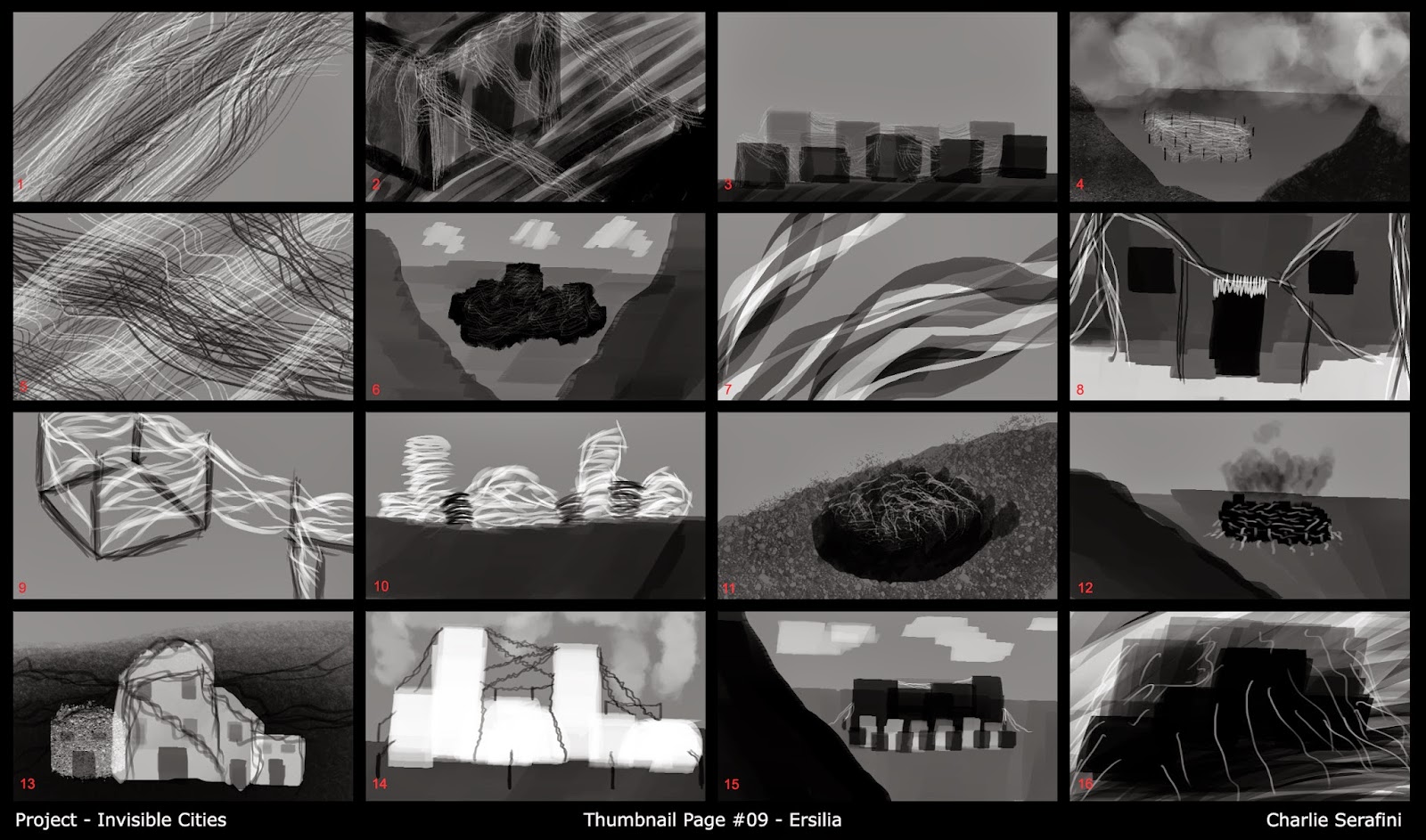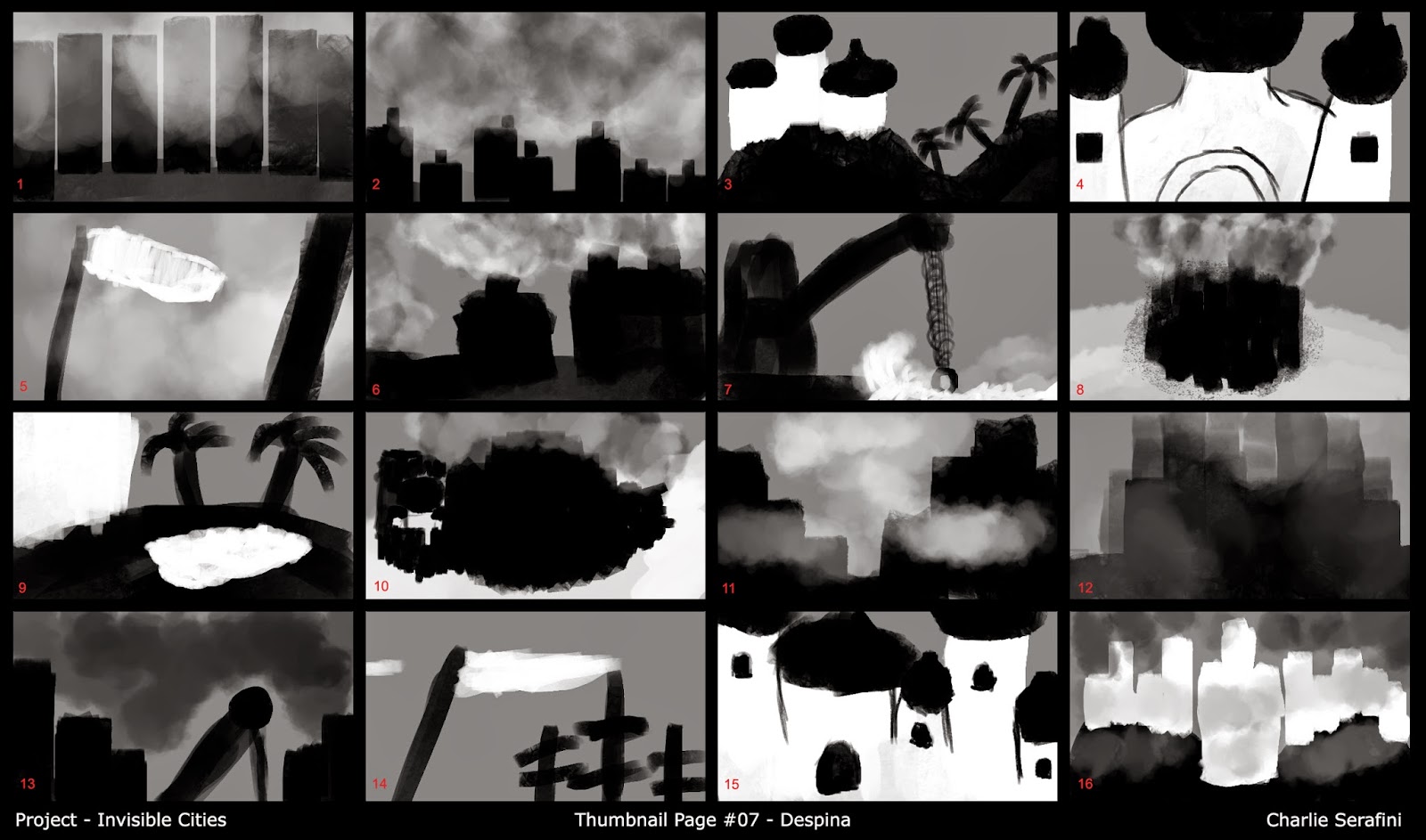Did the Maya tutorial on different techniques to model an object today. Made these egg cups using Polygon and NURBS modelling. I'm fairly familiar with the basics of Polygon modelling so I found that quite relaxing to do. I've never really had a go at NURBS modelling before so it was enjoyable to learn a different technique/approach to modelling.
Monday, 29 September 2014
Sunday, 28 September 2014
Invisible Cities - 4 More Pages Of Thumbnails
Been getting on with my thumbnails exploring more of the cities, I enjoyed these last 4 pages. Most of these cities are quite interesting so it was a lot of fun to imagine them.
First up we have Diomira, from all of the thumbnails I'd say 13 is my favourite. A city with sixty silver domes, that sparked most of the shapes involved with this sheet.
Next we have Ersilia, 6 and 10 are my favourite from this sheet. A city that keeps moving as it becomes impossible to live in due to the stringy labyrinth. I can see in 10 almost the shell of what the city would have looked like. I found this one quite interesting, almost a graveyard for buildings.
Fedora is the next city explored, I like 5 and 12. Most of the influence for these came from the little globes of Fedora's that could have been.
Lastly we have Isaura, 5,6 and 16 are my favourite and I definitely enjoyed this city. I imagined it as quite a dated city, with massive Roman aqueducts, old brick windmills and a very simplistic feeling to it. this could potentially be short listed to the city I want to focus on.
Any and all feedback is welcomed!
First up we have Diomira, from all of the thumbnails I'd say 13 is my favourite. A city with sixty silver domes, that sparked most of the shapes involved with this sheet.
Next we have Ersilia, 6 and 10 are my favourite from this sheet. A city that keeps moving as it becomes impossible to live in due to the stringy labyrinth. I can see in 10 almost the shell of what the city would have looked like. I found this one quite interesting, almost a graveyard for buildings.
Fedora is the next city explored, I like 5 and 12. Most of the influence for these came from the little globes of Fedora's that could have been.
Lastly we have Isaura, 5,6 and 16 are my favourite and I definitely enjoyed this city. I imagined it as quite a dated city, with massive Roman aqueducts, old brick windmills and a very simplistic feeling to it. this could potentially be short listed to the city I want to focus on.
Any and all feedback is welcomed!
Thursday, 25 September 2014
Le Voyage dans La Lune - Film Review
Fig. 1. Le Voyage dans La Lune poster.
George Melies’s Le Voyage dans La Lune (1902) is a creative and imaginative take on
science fiction. Although Le Voyage dans
La Lune is completely in black and white, you still get a sense of the
magical world that Melies wanted to create. It appears that the adventurers
that travel to the moon are perceived as wizards, as if the science behind it
would be too magical to perform. This idea is clearly seen through the first
few minutes of the film, as they all gather around in a room dressed in robes
and pointed hats, discussing the adventure they are about to embark on (see
fig. 2). As Sean Axmaker points out, “Historical importance aside, A Trip to the Moon is a delight, a work of pure, playful imagination, a
picture-book fantasy brought to life with intricate, hand-painted sets and a
whimsical portrait of science as wizardry by way of the industrial revolution,
and the then-revolutionary film effects perfected in his “trick films” are here
incorporated into the storytelling.”
(Axmaker, 2012).
Fig. 2. Wizard still
What
seems to stand out is the environment on the moon, Melies created a sci-fi
fantasy environment that has aged well. The cave filled with giant mushrooms is
a brilliant fantasy scene that engages the viewer, it’s the first time you’re
revealed the creatures that live on the moon and with a swift hit and a puff of
smoke you get drawn in to this world that is far from the ordinary (see fig.
3). “It’s astonishing how many delightful
details are squeezed into this miniature film, from the alien costumes (bony
and spindly, they resemble skeletal bugs more than anything else) to the fact
that the astronomers who embark on this space voyage feel the need to take
umbrellas.” (Larsen, 2013).
Fig. 3. Mushroom cave
“Melies was the inventor of special effects, and he employs
them liberally in this charming yarn, presented in this set not only in its
color incarnation but also in the more familiar black-and-white rendition.” (Brunson, 2012). In agreement with this point it seems
that Le Voyage dans Le Lune was the
pioneering film for special effects, in one way or another we have this film to
thank for the CG masterpieces that are flooding our cinematic experiences
today.
Illustration
list
Melies, G. (1902). Figure 1. Le Voyage dans
La Lune poster. http://www.pinterest.com/pin/162270392798648230/ (Accessed on
25/09/2014)
Melies, G. (1902). Figure 2. Wizards still.
http://filmabinitio.blogspot.co.uk/2010/09/1910-wonderful-wizard-of-oz-otis-turner.html
(Accessed on 25/09/2014)
Melies, G. (1902). Figure 3. Mushroom cave
still. http://drnorth.wordpress.com/2010/06/10/a-trip-to-the-moon-le-voyage-dans-la-lune/
(Accessed on 25/09/2014)
Bibliography
Axmaker, S. (2012). seanax.com. http://www.seanax.com/2012/04/11/cinema-landmark-a-trip-to-the-moon-restored/
(Accessed on 25/09/2014)
Brunson, M. (2012). clclt.com. http://clclt.com/charlotte/cormans-world-a-trip-to-the-moon-among-new-home-entertainment-titles/Content?oid=2682746
(Accessed on 25/09/2014)
Larsen, J. (2013). larsenonfilm.com. http://www.larsenonfilm.com/a-trip-to-the-moon
(Accessed on 25/09/2014)
Wednesday, 24 September 2014
Invisible Cities - A Few More Thumbnails
I did a few more pages of thumbnails today, exploring a few different cities. I also finished off page 3 from monday.
I like number 12 and 10 from thumbnail page 3, I tried using a mixture of tools to help sped up my painting. Still getting to grips with using the lasso and marquee tool.
I'm quite fond of the shapes in 9, 10 and 12. I found this city quite hard to imagine however it was also a very interesting concept. A city with no buildings, just a waste land of pipes.
Number 4 and 12 are my favourite from this page, I like the idea of spacing the city out around the canals.
I like 2, 5 and 16 from this page, I found this one a little more difficult however it is an fascinating concept to have a city underground.
I like the silhouette for 8 and 11, I found this particular city compelling. The idea that the city almost has 2 faces, seen differently by the people that visit it.
I like number 12 and 10 from thumbnail page 3, I tried using a mixture of tools to help sped up my painting. Still getting to grips with using the lasso and marquee tool.
I'm quite fond of the shapes in 9, 10 and 12. I found this city quite hard to imagine however it was also a very interesting concept. A city with no buildings, just a waste land of pipes.
Number 4 and 12 are my favourite from this page, I like the idea of spacing the city out around the canals.
I like 2, 5 and 16 from this page, I found this one a little more difficult however it is an fascinating concept to have a city underground.
Any and all feedback is welcomed. Still trying to just throw shapes out there before I start refining these thumbnails.
Das Cabinet des Dr. Caligari Film Review
Fig. 1. Das Cabinet des Dr. Caligari poster.
Robert Wiene’s Das Cabinet des Dr. Caligari (1920) is a striking, powerful film,
which uses abstract scenes to aid the narrative. This film can seem quite
confusing from start to finish and you can expect to be left questioning what
had taken place by the end. It takes you on a journey through the recollection
of Francis, set in the town of Holstenwall at the time of the annual fair. The
strange and mysterious Dr. Caligari exhibits the somnambulist Cesare, who
predicts the death of Francis’s friend Alan. Murder, kidnapping and a strange
plot twist follow leading the viewer slightly disorientated, unsure of what to
believe. “Now
lovingly polished up to 4K standards, the world’s first horror movie (1920) is
as eerily beautiful as ever. Robert Wiene uses jagged sets, non-naturalistic
acting and flashbacks within flashbacks to discombobulate, before delivering a
twist so blindsiding it’s ripped off to this day.”
(Smith, 2014).
Fig. 2. Bridge still
It becomes very noticeable just how
inspirational Das Cabinet des Dr.
Caligari is for the impact it had on modern films. Tim Burton’s work
appears to be hugely impacted by Das
Cabinet des Dr. Caligari, The abstract powerful scenes that can be seen
throughout the film have translated into many of Burton’s work, an example of
such is the environment of Tim Burtons The
Nightmare Before Christmas (1993), with its crooked and chaotic structures (see fig. 2.).
“Warped in all senses, fascinating and bizarre:
this is the 1920 silent movie by Robert Wiene – now re-released in cinemas
– that lay down a template for today's scary movies, noirs and psychological
thrillers.”
(Bradshaw, 2014).
Fig. 3. Town still
It is possible that Wiene used the
environment to portray a sense of insanity and chaos; it is noticeable that the
environment compliments the narrative giving the viewer an understanding of the
despair throughout the film (see fig. 3.). John Bleasdale states “The pointy jaggedness of the
environment anticipates the dagger of the murderer when it appears, like a long
fatal finger, suggesting that murder is in the weave of the story from the very
beginning.” (Bleasdal, 2014), this seems to
demonstrate that the environment was the main story telling asset throughout Das Cabinet des Dr. Caligari.
Illustration list
Wiene, R. (1920). Figure 1. Das Cabinet des Dr. Caligari poster.
http://www.openculture.com/2013/10/the-cabinet-of-dr-caligari-see-the-restored-version.html
(Accessed on 24/09/2014)
Wiene, R. (1920). Figure 2. Bridge still. http://thequietus.com/articles/01003-caligari
(Accessed on 24/09/2014)
Wiene, R. (1920). Figure 3. Town still. http://arttattler.com/archiveweimarcinema.html (Accessed on 24/09/2014)
Bibliography
Bleasdale, J. (2014).
Electricsheepmagazine.co.uk. http://www.electricsheepmagazine.co.uk/reviews/2014/08/01/the-cabinet-of-dr-caligari/
(Accessed on 24/09/2014)
Bradshaw, P. (2014). Theguardian.com. http://www.theguardian.com/film/2014/aug/28/the-cabinet-of-dr-caligari-film-review
(Accessed on 24/09/2014)
Smith, A. (2014). empireonline.com. http://www.empireonline.com/reviews/reviewcomplete.asp?FID=138758
(Accessed on 24/09/2014)Monday, 22 September 2014
Invisible Cities (creative work) - Photoshop Brush Exercises
Started using Photoshop today, here's the result. I found the second exercise quite difficult to start with, using the marquee and lasso tool to create the thumbnails. However I can see the benefit from using these tools so I plan on trying to use them more for my next batch of thumbnails. I ran out of time on the third sheet so it's a work in progress which I will finish off very soon.
Any and all feedback is welcomed!
Any and all feedback is welcomed!
Tuesday, 2 September 2014
CAA Summer Project - Structure & Machine Turnaround
I decided to carry on creating my turnarounds using Photoshop to get more familiar with digital painting.
Subscribe to:
Posts (Atom)






















